Nikon manufactures three lens converters for modifying the focal length of the on-camera lens. The following image shows all three Nikon lens converters. From left to right, are the 0.2x Fisheye Converter FC-E9, 0.80x Wide Angle Converter WC-E80 and 1.5x Wide Angle Converter TC-E15ED.
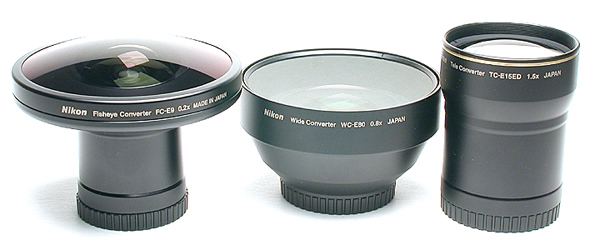
|
| All Three Nikon lens converters |
All of these converters are screwed on to an adapter, which, in turn, is screwed on to the camera body. Each lens has a magnification (i.e., 0.2x, 0.8x and 1.5x). When a lens is used with the on-camera lens, the combined focal length is the product of the given magnification and the focal length of the on-camera lens. Recall that the on-camera lens has focal length in the range of 35mm and 280mm (35mm equivalent). If the wide angle converter WC-E80 is used, the combined focal length is in the range of 28mm (=35mm×0.8) and 224mm (=280mm×0.8).
These lens converters are of type afocal. Parallel light rays entering an afocal lens are also parallel when they exit; however, the diameter of the exiting parallel light rays may be different from the diameter of the entering light rays. Thus, an afocal lens does not have focal length, or, its focal point is at infinity. As a result, afocal lens are only used for modifying focal lengths and other optical characteristics, and must be used with other prime lenses. This means afocal lens are not supposed to be used alone.
Because converters are attached to the on-camera lens, creating combined lenses of modified focal lengths, the optical problems of the lens converter will be magnified by the on-camera lens. These include lens flare, ghost image, field curvature, aberration and so on. Please refer to On-Camera Lens Overview for the details.
Note that these converter lenses cannot be mounted on to the camera. You will need appropriate adapter tubes. Click here for the details.
As mentioned in previous section, the three lens converters and the on-camera lens cover focal lengths from 7mm to 420mm (35mm equivalent). The following table shows the focal length range and the corresponding lens converter. In general, if a focal length can be obtained with the on-camera lens, use the on-camera lens rather than a lens converter. For example, the focal length range of the WC-E80 overlaps with that of the on-camera lens (i.e., 35mm to 224mm). If the desired focal length is in this range, use the on-camera lens for better image quality even though WC-E80 can also do the job. More precisely, use a lens converter only if the on-camera lens cannot reach the desired focal length (e.g., 28mm). Note that when the TC-E15ED is mounted, not the whole focal length range of the 5700 can be used. In fact, only a section in the range of 334mm and 420mm will not cause vignetting. Thus, the following table lists 334mm to 420mm as the usable focal length range of the TC-E15ED.
| Converter | Fisheye | Wide Angle | On-Camera | TC-E15ED |
| Focal Length | 7mm-28mm | 28mm-35mm | 35mm-280mm | 334mm-420mm |
The next few images were all taken at the same position with different focal lengths. The first one is 28mm using WC-E80. The next six images were taken using the on-camera lens with focal lengths 35mm, 50mm, 100mm, 135mm, 200mm and 280mm. The last two were taken using TC-E15ED. When the TC-E15ED is mounted on a 5700, the on-camera lens cannot be zoomed back too much because it would cause vignetting. The 334mm image shows the shortest focal length for which a 5700 plus TC-E15ED does not have vignetting. Note that this 334mm is an approximation and your result may vary. Therefore, when the TC-R15RD is on a 5700, the usable focal length is between 334mm and 420mm, and there is a focal length gap between 280mm and 334mm.
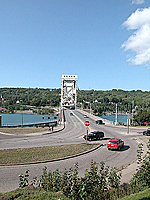
|
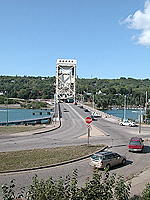
|
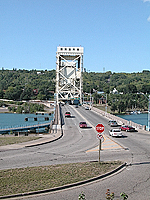
|
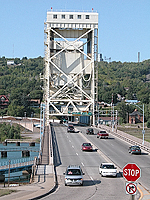
|
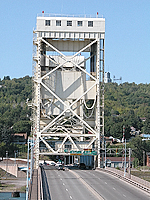
|
| 28mm | 35mm | 50mm | 100mm | 135mm |
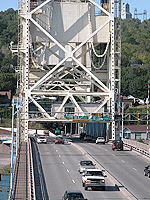
|
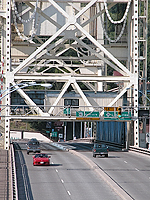
|
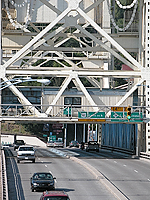
|
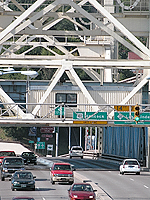
|
| 200mm | 280mm | 334mm | 420mm |
| Click on the image to see a larger one | |||
A serious problem when using a converter lens is that the converter can partially block the flash sensor coverage and sometimes the internal flash as well. Thus, either the internal flash may not be used or may cast a shadow in the lower portion of the captured image if the internal flash fires. The following image shows the flash sensor and the internal flash.
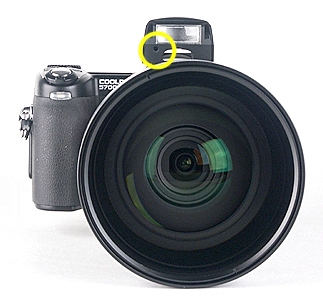
The following table lists the thread size of each converter. Both the FC-E9 Fisheye and the WC-E80 wide angle converters do not have threads for using filters. However, the TC-E15ED tele converter does have a 58mm thread.
| Converter | Filter Thread Size |
| FC-E9 | not applicable |
| WC-E80 | not applicable |
| TC-E15ED | 58mm |